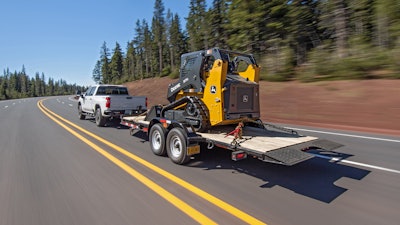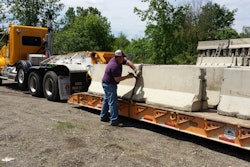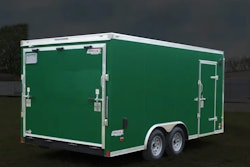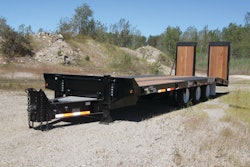
Technology advances promise to reduce the stress and increase safety when hitching and pulling equipment trailers with your pickup truck. Cameras, radar, integrated trailer brakes and tire pressure monitoring systems are all becoming more popular.
Large in-dash screens in current generation pickup trucks provide several camera views which make backing up to and connecting a trailer a one-person operation. It eliminates the guesswork when backing up to the trailer hitch. The camera pointed at the pickup trailer hitch ensures perfect alignment every time.
Rear visibility when pulling the trailer down the road or backing into tight spaces can be simplified with trailer-mounted auxiliary cameras. Such devices are currently offered by both Ram Trucks and General Motors.
New Camera Views Reduce Blind Spots
Ram Heavy Duty pickups feature a cargo-view camera to monitor payload in the bed. This camera can also be used to align fifth wheel and gooseneck trailers with grid lines. A 360-degree surround-view camera with trailer reverse guidance view provides a single display-screen view of both sides of a trailer to assist drivers in maneuvering towing setups. An auxiliary exterior camera improves visibility with custom positioning in and behind trailers. There are also cameras in the mirrors and when you are pulling a trailer you can get a split pane view on the 12 in. center console screen that shows each side of the trailer for backing into tight spaces or next to buildings. Spotter lights in the mirrors allow visibility down the sides of the trailer in low-light conditions.
General Motors recently introduced camera technology that provides several unique views. The 2020 Silverado HD and GMC Sierra HD offer up to 15 unique camera views, including HD Surround Vision, Bed View, and an industry-first transparent trailer view. The transparent trailer feature uses the tailgate-mounted camera and an available accessory camera mounted on the rear of the trailer. The resultant image allows the driver to virtually see through the trailer, a benefit when navigating parking lots, merging into traffic or when making a tight turn.
Other views, including Rear Side View and Bowl View also enhance the towing experience. Rear Side View shows the rear sides of the vehicle to help allow the driver to view objects near the vehicle. Bowl view provides rear-facing 3D surround view that gives a sense of the height of objects surrounding the vehicle while backing.
Backing trailers into tight spaces can prove challenging to some drivers. Ford simplifies this task with Pro Trailer Backup Assist. A knob mounted near the reverse camera allows drivers to easily steer the trailer with hands off the steering wheel. The truck’s Trailer Reverse Guidance system shows trailer angle and direction and provides steering suggestions to direct a trailer backward most efficiently. Both systems are built to accommodate all trailer styles, including fifth wheel and gooseneck trailers.
Collision Avoidance Adapts for Towing
Collision avoidance technologies also help keep drivers safe while towing. For instance, Ford adapted its Blind Spot Information System (BLIS) to include the trailer being towed. The BLIS monitors for vehicles in your blind spots, even when towing.
The Ram 3500 dual rear wheel pickup includes specifically designed sensors to cover the added width of dual rear wheels, giving a wider span of coverage when backing up with limited view.
Identify Limitations
Safe towing requires an understanding of trailer and tow vehicle capabilities. Often the weight of equipment to be transported is miscalculated, resulting in overloading the truck and trailer. Each vehicle manufacturer assigns a tow rating, which is the maximum weight of the tow vehicle when loaded.
Make sure your tow vehicle is up to the task. The tow vehicle’s hitch rating should meet or exceed the GVWR of the trailer you’re towing. This applies to the receiver hitch itself, as well as the ball mount and ball or pintle hitch assembly.
Similarly, the trailer’s gross vehicle weight rating (GVWR) is printed on a label or placard - often referred to as the certification or VIN label - mounted on the left front side of the trailer, typically within 6 inches of the floor line or near the coupler. The GVWR is the maximum a trailer should ever weigh when loaded.
The trailer gross axle weight rating (GAWR) is also listed on the certification label. According to the Trailer Safety Industry Coalition (TISC), this indicates the most weight an axle can bear. If the trailer has more than one axle, each axle will have weight rating information provided on the certification label.
The construction of the trailer also deserves close examination. Not all trailers are constructed the same. Make sure there are sufficient crossmembers underneath the trailer to support the specific load you plan to haul. A 7,000-lb. GVW car hauler trailer may not be appropriate for a skid-steer loader. Even though the overall weight capacity may be sufficient, the trailer is not designed for the weight loading produced by that piece of equipment. A car has a more dispersed weight where some construction equipment can produce very concentrated weight loading on the trailer.
Note that trailers have a speed rating. Manufacturers usually state a 55- or 65-mph rating. The slower a rig travels, the less added weight or stress is placed on the trailer. The key is to select a unit that will perform at a fleet’s normal operating speed.
Load the Trailer Properly
Weight distribution on a trailer is critical to safe performance. Too much of the load on the front is going to cause the tow vehicle to be unstable and it may cause under-steer or jackknifing. Too much on the back it lifts the rear end of the tow vehicle, which causes trailer instability and swaying. The tow vehicle needs to be level. The front end of the truck should come back down to a level position.
The hitch height is critical in ensuring that the trailer tows properly according to Felling Trailers. As a rule, when on a flat, level loading surface, the trailer should be higher in the front than the rear, so that when the trailer is fully loaded, the truck and trailer are sitting level.
Don't put excessive weight on the trailer tongue. A 10% to 15% tongue weight is common for bumper pull trailers and 20% to 25% for goosenecks and fifth wheels. Under-loaded or negative tongue weight is worse than excessive tongue weight and could cause loss of control according to Felling Trailers.
Take the time initially to understand where the equipment should be loaded. You may want to put a stop on the trailer. This could be a piece of angle iron that tells the operator where the vehicle being loaded needs to stop. It can be made to clip on so it can be easily removed if you need to move other equipment.
In addition, don't place excessive weight on either side of the trailer. If you do, the tire weight ratings on the heavy side will likely be exceeded and the trailer will not handle correctly.
Even when properly loaded, a trailer will change vehicle dynamics. Any time a trailer is added to the back of a vehicle — no matter the size — there is going to be a significant degradation in the vehicle’s performance, whether it’s acceleration, braking, handling, or stability.
Don’t Skip Pre-trip Inspection
Once a trailer is matched to the load, a pre-trip inspection is in order and should be done prior to taking off with each load.
Walk around the trailer and ensure there is no damage or cracks in the unit’s frame. Look for visible damage, such as chafed hydraulic hoses, which could spring a leak and cause the system to fail. Inspect tie-down equipment, such as chains, binders and straps, for broken parts and pieces and make sure they are rated appropriately. These ratings can be found on the equipment being hauled. Also ensure the trailer isn’t leaning or sagging to one side.
Check brakes and confirm the tires are properly inflated to the recommended psi. Over- or under-inflated tires won’t have the proper load rating so they won’t carry the weight like they should, which adds stress to the trailer. Traveling with improper tires can also cause a blowout when hauling heavy loads. Drivers can find the psi, size, ply and load rating on the manufacturer’s VIN tag.
Improper inflation pressure is the main cause of trailer tire failure. Because they carry greater loads, tire pressure for trailers is higher than the tow vehicle according to TISC. Tires can lose 1 to 3 psi per month. An underinflated tire builds heat faster, leading to quicker degradation.
Check the lights. With the vehicle’s headlights on, all the relevant running lights, turn signals and brake lights should operate properly.
Periodically use a torque wrench to check the tightness of trailer wheel lug nuts. Tandem axles don’t steer so the wheels on them are under greater stress when turning corners and likely to becoming lose according to TISC.
Every time you come to a stop or every time you get out of your vehicle, walk around the trailer. There are many dynamics and things can come loose. Check the safety chain. Check the coupler. Check to make sure the bolts are good in the hangers - it is fairly easy to see. Check your cargo straps. It needs to be a habit.
Ensure Proper Tires
Trailer tires may be worn out even if they have plenty of tread left. Sitting for extended periods of time or carrying excessive loads shortens tire life.
The average life of a trailer tire is about five years under normal use and maintenance conditions according to the Trailer Safety Industry Coalition (TSIC). After three years, consider replacing the trailer tires with new ones, even if the tires have adequate tread depth.
The type of tires designates your travel speed. Most trailer tires are a Special Trailer (ST) version. ST tires don't have a speed rating like normal passenger car and truck tires. The trailer owner's manual should tell you the proper speed [at which] those tires can be used.
Properly Secure the Load
Chain and binder selection are critical to secure heavy equipment loads. Chain is not a large investment. If your chain is suspect, replace it. Chain comes in various grades and thickness. The most commonly used chain in securing loads is Grade 70, 3/8 in., which has a 6,600-lb. maximum pull. For heavier loads, there is a Grade 70, 1/2 in. with 11,300 maximum pull.
Binders, chains, hooks, and clevis pins all should be permanently marked with their capacity. Ratchet binders have twice the strength of mechanical lever binders, and they are also much easier to tighten than the lever binders.
Whether its chains, ropes, wraps or webbing, whatever secures the load must comply with the Federal Motor Carrier Regulations regarding the Aggregate Working Load Limit. The basic requirement is that tiedowns must have the combined strength equal to at least 50 percent of the load being secured.
The way to calculate the aggregate load limit is to add 50 percent of the working load limit of each tiedown used to secure the load; and if the total is greater than 50 percent of the load being carried, it is secured within the limit requirements. For example, assume that a trailer is being loaded with an 11,000-lb. telehandler, which will be held with four Grade 70, 3/8-in. chains. Since each chain is rated at 6,600 maximum pull, the aggregate working load limit is 6,600 lbs. divided by two. The total of the four chains added together is 13,200 lbs.

![Doosan Bobcat Wacker Neuson Stack 2ec Js Pb V6e[1]](https://img.greenindustrypros.com/mindful/acbm/workspaces/default/uploads/2025/12/doosan-bobcat-wacker-neuson-stack2ecjspbv6e1.CPyyz8ubHn.png?auto=format%2Ccompress&bg=fff&fill-color=fff&fit=fill&h=100&q=70&w=100)








![Doosan Bobcat Wacker Neuson Stack 2ec Js Pb V6e[1]](https://img.greenindustrypros.com/mindful/acbm/workspaces/default/uploads/2025/12/doosan-bobcat-wacker-neuson-stack2ecjspbv6e1.CPyyz8ubHn.png?ar=16%3A9&auto=format%2Ccompress&bg=fff&fill-color=fff&fit=fill&h=135&q=70&w=240)








